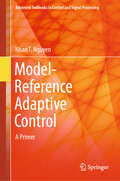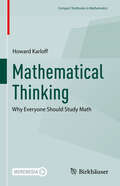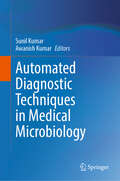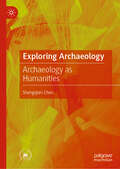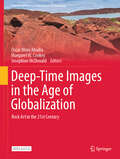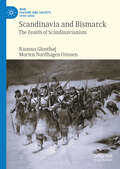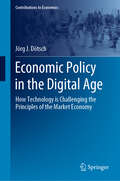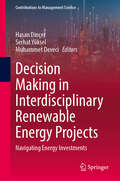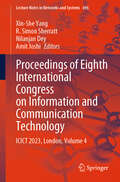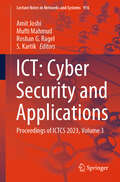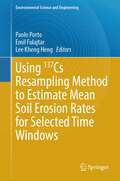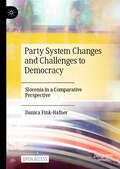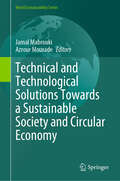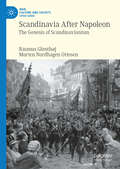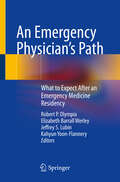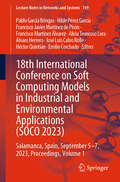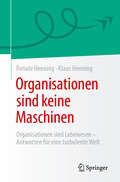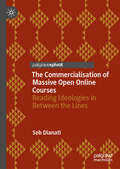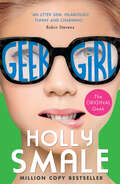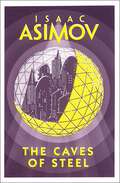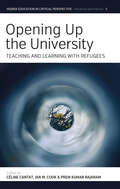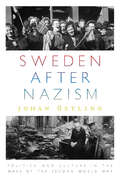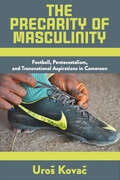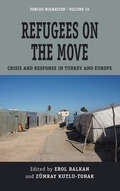- Table View
- List View
Model-Reference Adaptive Control: A Primer (Advanced Textbooks in Control and Signal Processing)
by Nhan T. NguyenThis textbook provides readers with a good working knowledge of adaptive control theory through applications. It is intended for students beginning masters or doctoral courses, and control practitioners wishing to get up to speed in the subject expeditiously. Readers are taught a wide variety of adaptive control techniques starting with simple methods and extending step-by-step to more complex ones. Stability proofs are provided for all adaptive control techniques without obfuscating reader understanding with excessive mathematics. The book begins with standard model-reference adaptive control (MRAC) for first-order, second-order, and multi-input, multi-output systems. Treatment of least-squares parameter estimation and its extension to MRAC follow, helping readers to gain a different perspective on MRAC. Function approximation with orthogonal polynomials and neural networks, and MRAC using neural networks are also covered. Robustness issues connected withMRAC are discussed, helping the student to appreciate potential pitfalls of the technique. This appreciation is encouraged by drawing parallels between various aspects of robustness and linear time-invariant systems wherever relevant. Following on from the robustness problems is material covering robust adaptive control including standard methods and detailed exposition of recent advances, in particular, the author’s work on optimal control modification. Interesting properties of the new method are illustrated in the design of adaptive systems to meet stability margins. This method has been successfully flight-tested on research aircraft, one of various flight-control applications detailed towards the end of the book along with a hybrid adaptive flight control architecture that combines direct MRAC with least-squares indirect adaptive control. In addition to the applications, understanding is encouraged by the use of end-of-chapter exercises and associated MATLAB® files. Readers will need no more than the standard mathematics for basic control theory such as differential equations and matrix algebra; the book covers the foundations of MRAC and the necessary mathematical preliminaries.
Mathematical Thinking: Why Everyone Should Study Math (Compact Textbooks in Mathematics)
by Howard KarloffThis textbook invites readers to explore mathematical thinking by finding the beauty in the subject. With an accessible tone and stimulating puzzles, the author will convince curious non-mathematicians to continue their studies in the area. It has an expansive scope, covering everything from probability and graph theory to infinities and Newton’s method. Many examples of proofs appear as well, offering readers the opportunity to explore these topics with the amount of rigor that suits them. Programming exercises in Python are also included to show how math behaves in action.Mathematical Thinking is an ideal textbook for transition courses aimed at undergraduates moving from lower level to more advanced topics, as well as for math recruitment and invitational courses at the freshman or sophomore level. It may also be of interest in computer science departments and can be used as a supplemental text for courses in discrete mathematics and graph theory.
Automated Diagnostic Techniques in Medical Microbiology
by Sunil Kumar Awanish KumarThis book will explore the knowledge of current diagnostic automation techniques applied in the field of clinical microbiology, tropical diseases, POCT, etc. There is no such type of book related to this topic. This book will help clinicians, microbiologists, and researchers to make diagnostic algorithms for infectious diseases and help them in early diagnosis. Automation in clinical microbiology has revolutionized routine practice in diagnostic cum research in medical microbiology. This book covers the recent updates and advances in diagnostic microbiology and provides new techniques related to Genomic, Proteomic, and metabolomics in microbiology. This book will intensely discuss the new and innovative automation techniques available for diagnosis in the microbiology laboratory. This book is more focused on automation techniques, which are used in the early detection of infectious diseases even caused by rare microorganisms. Furthermore, this book has complied with the chapters that provide insights to readers with comprehensive and usable knowledge on automation techniques in diagnostic microbiology.
Exploring Archaeology: Archaeology as Humanities
by Shengqian ChenThis book looks inward to reveal and analyse problems in archaeology itself. The subject explored in this volume include: humanistic attributes of archaeology, various archaeological theory, challenges in the development of archaeology, China Archaeology paradigms and "Chinese School", responsibilities and status of archaeology in society, and prospects of Archaeology in China. With years of engagement in philosophy and theory studies, the author raised many bold questions and contributed unique and original views. While the archaeological circle remained tacit about -"Chinese School"- a term proposed by leading authority Professor Su Bingqi, the author bravely voiced that archaeology needs a "Chinese school". The "Chinese school" would facilitate both the reconstruction of cultural significance and the vying for international discourse power. The author also puts forward his thoughts on the current public archaeological fever, explaining and reflecting on the social responsibility, discourse power and how to present the archaeological discovery in a more accurate and efficient way to the public.
Deep-Time Images in the Age of Globalization: Rock Art in the 21st Century (Interdisciplinary Contributions to Archaeology)
by Oscar Moro Abadía Margaret W. Conkey Josephine McDonaldThis open access volume explores the impact of globalization on the contemporary study of deep-time art. The volume explores how early rock art research’s Eurocentric biases have shifted with broadened global horizons to facilitate new conversations and discourses in new post-colonial realities. The book uses seven main themes to explore theoretical, methodological, ethical, and practical developments that are orienting the study of Pleistocene and Holocene arts in the age of globalization. Compiling studies as diverse as genetics, visualization, with the proliferation of increasingly sophisticated archaeological techniques, means that vast quantities of materials and techniques are now incorporated into the analysis of the world’s visual cultures. Deep-Time Images in the Age of Globalization aims to promote critical reflection on the multitude of positive – and negative – impacts that globalization has wrought in rock art research. The volume brings new theoretical frameworks as well as engagement with indigenous knowledge and perspectives from art history. It highlights technical, methodological and interpretive developments, and showcases rock art characteristics from previously unknown (in the global north) geographic areas. This book provides comparative approaches on rock art globally and scrutinises the impacts of globalization on research, preservation, and management of deep-time art. This book will appeal to archaeologists, social scientists and art historians working in the field as well as lovers of rock art.
Scandinavia and Bismarck: The Zenith of Scandinavianism (War, Culture and Society, 1750–1850)
by Rasmus Glenthøj Morten Nordhagen OttosenThis book accounts for Scandinavian unification efforts in a time of great upheaval. The ideological repercussions of the European revolutions of 1848-1849 and the Crimean War (1853-1856) transformed both the international political system and nationalism into more ‘realist’ types. The First Schleswig War (1848-1851) having nearly turned into one of Scandinavian unification, the influence of Scandinavianism extended into the Danish, Swedish and Norwegian courts, cabinets and parliaments, attracting interest from the great powers. The Crimean War offered another window of opportunity for Scandinavian unification, before the Danish-German conflict over the duchies of Schleswig and Holstein nearly united Scandinavia upon the outbreak of the Second Schleswig War in 1864. The ultimate failure of Scandinavianism in its unification efforts was not predetermined, although historiography has made it appear as such. Napoleon III, Cavour and Bismarck all actively contributed to plans for Scandinavian unification, the latter even declaring himself as “very strongly Scandinavian”.
Economic Policy in the Digital Age: How Technology is Challenging the Principles of the Market Economy (Contributions to Economics)
by Jörg J. DötschThis book addresses how digital technology is challenging the principles of the market economy and the consequences for economic policy. Applying the approach of the Freiburg School as a heuristic perspective, the study examines the concrete effects of digital technology on the price system and monetary policy, the openness of markets, the role of private property, and labour markets. It highlights the emergence of digital innovations such as digital currencies, digital goods, artificial intelligence, digital platforms and the sharing economy and discusses the challenges these innovations pose for economic governance and the development of adequate economic policy instruments. This comprehensive overview provides a basic understanding of the scope of the digital transformation and addresses a wide scale of important aspects of e.g. competition and trade policy, the impact of robotisation on labour market policy, and how economic policy must incorporate social aspects. The book appeals to scholars and students of economics, public management professionals, and anyone interested in the challenges of digitalisation in the context of economic policy.
Decision Making in Interdisciplinary Renewable Energy Projects: Navigating Energy Investments (Contributions to Management Science)
by Hasan Dinçer Serhat Yüksel Muhammet DeveciThis edited book presents a comprehensive analysis of the multidimensional aspects associated with decision making in renewable energy investment projects. It delves into the interplay between interdisciplinary studies, sustainability considerations, and circular economy principles within the renewable energy sector. By examining the impact of these interconnected domains, the book offers valuable insights into the challenges and opportunities inherent in decision making for renewable energy investments. The book is tailored to a diverse audience, including researchers, scholars, and professionals in the fields of renewable energy, sustainability, circular economy, and business management. It is equally suitable for graduate and undergraduate students studying environmental studies, renewable energy, sustainability, and related disciplines. Professionals working in the renewable energy industry, including project developers, investors, and policymakers, will find valuable insights to inform their decision-making processes. Additionally, engineers, economists, social scientists, and environmental consultants interested in interdisciplinary studies and their intersection with renewable energy will benefit from the book's comprehensive analysis.
Proceedings of Eighth International Congress on Information and Communication Technology: ICICT 2023, London, Volume 4 (Lecture Notes in Networks and Systems #696)
by Xin-She Yang R. Simon Sherratt Nilanjan Dey Amit JoshiThis book gathers selected high-quality research papers presented at the Eighth International Congress on Information and Communication Technology, held at Brunel University, London, on 20–23 February 2023. It discusses emerging topics pertaining to information and communication technology (ICT) for managerial applications, e-governance, e-agriculture, e-education and computing technologies, the Internet of Things (IoT) and e-mining. Written by respected experts and researchers working on ICT, the book offers a valuable asset for young researchers involved in advanced studies. The work is presented in four volumes. Chapter “Ontology Engineering to Model the European Cultural Heritage: The Case of Cultural Gems” is available open access under a Creative Commons Attribution 4.0 International License via SpringerLink.
ICT: Proceedings of ICTCS 2023, Volume 3 (Lecture Notes in Networks and Systems #916)
by Amit Joshi Mufti Mahmud Roshan G. Ragel S. KartikThis book contains best selected research papers presented at ICTCS 2023: Eighth International Conference on Information and Communication Technology for Competitive Strategies. The conference will be held in Jaipur, India during 8 – 9 December 2023. The book covers state-of-the-art as well as emerging topics pertaining to ICT and effective strategies for its implementation for engineering and managerial applications. This book contains papers mainly focused on ICT for computation, algorithms and data analytics and IT security. The work is presented in three volumes.
Using 137Cs Resampling Method to Estimate Mean Soil Erosion Rates for Selected Time Windows (Environmental Science and Engineering)
by Paolo Porto Emil Fulajtar Lee Kheng HengThis book provides guidelines for using a new approach of resampling the Cs-137 radionuclide tracer which is used to estimate soil erosion rates. The Cs-137 resampling approach will improve significantly the use of the Cs-137 method for assessment of soil erosion, because resampling the radionuclide repeatedly (at least two times, but more sampling campaigns are possible) allows to avoid several methodological difficulties associated with Cs-137 method, namely the problems with small-scale spatial heterogeneity, the question of representativeness of reference site, reference samples, and inappropriate time extent of evaluated period. All these methodological problems are very important for reliability and accuracy of erosion rates estimated by Cs-137 method. If using single sampling approach, the small-scale spatial heterogeneity can be overcome by high number of sampling points, but this is time and labour demanding solution increasing the expenses of the erosion research. The representativeness of reference site is evaluated usually on the basis of expert judgement and knowledge of land use history of studied area, but this approach is often uncertain because the expert judgement can be subjective and the data on land use history is often not sufficient. Further, in many areas an appropriate reference site is not available, what limits the territorial extent of using Cs-137 method. The resampling approach offers its second sampling to be done in a proximate vicinity of the same points sampled during the first sampling campaign. A great advantage is the possibility to decide how long time windows should be investigated. Choosing the time schedule of first and second sampling allows to shorten the time window and adjust it to the study objectives. This is a great improvement of the Cs-137 method, because the time period since the Cs-137 fallout is still growing and thus if using the single sampling approach the results refer to still longer and longer time window(since the Cs-137 fallout until the sampling time), and this period (recently ca 60 years assuming the maximum Cs-137 fallout in 1963) is too long to represent stable land use, because land uses are changing over the time and having the same land use over six decades is rather rare. The improvement of Cs-137 method achieved by resampling approach is significantly contributing to understanding the erosion dynamics and estimating its rates under changing environmental conditions (such as land uses, weather), and it will bring a significant benefit to soil conservation programmes, because Cs-137 method is indispensable for assessing the medium and long term soil erosion rates, and this information is among the basic inputs needed for planning and designing soil conservation measures.
Party System Changes and Challenges to Democracy: Slovenia in a Comparative Perspective
by Danica Fink-HafnerThis open access book focuses on the nexus between “party system stability” and “democratic consolidation”, using Slovenia as a case study. Its findings are presented from a comparative perspective to illustrate the commonalities and differences found in research on Central European post-socialist countries and former Yugoslav countries. On the one hand, Slovenia’s characteristics (including the characteristics of its transition to democracy) are far more similar to those of Central European post-socialist countries than Western Balkan countries. On the other, Slovenia shares some similarities with other parts of the former Yugoslavia – especially its experiences with the political system of socialist self-management, elements of a market economy under socialism, and war following the end of socialism (albeit the conflict in Slovenia was very short and rather mild in comparison to those in other parts of socialist Yugoslavia). Slovenia’s experiences with rapid but limited democraticbacksliding under the Janša government (March 2019–June 2022) were halted by the 2022 national election – in contrast to the more widely known cases of Hungary and Poland, where such backsliding took place incrementally over a longer period of time that included several election cycles.
Technical and Technological Solutions Towards a Sustainable Society and Circular Economy (World Sustainability Series)
by Jamal Mabrouki Azrour MouradeResource depletion and ecological risks are more than ever at the heart of societal and economic debates. In the 1970s, the developed countries saw the Fordist growth regime crumble in parallel with the growing awareness of the ecological issue. Since the first industrial revolutions, technological dynamics have been the cause of many environmental problems, and there is a consensus on the diagnosis. Integrated technologies reduce resource use and/or pollution at source by using cleaner production methods. This generally leads to a reduction in the by-products, energy inputs and resources used by companies to produce goods.Integrated production technologies reduce negative environmental impacts at source by substituting or modifying cleaner technologies. Examples of integrated, or cleaner, production technologies are the recirculation of materials, the use of environmentally friendly materials (such as the substitution of water for organic solvents), etc. However, the implementation of integrated production technologies is often hampered by obstacles related to cost, coordination and skill inertia problems and to the productive organisation of companies. In addition to the high investment costs of new integrated technologies, additional barriers may emerge depending on the nature of the environmental problem and the type of environmental regulation in question.
Scandinavia After Napoleon: The Genesis of Scandinavianism (War, Culture and Society, 1750–1850)
by Rasmus Glenthøj Morten Nordhagen OttosenThis book explores the intellectual grounds of Scandinavianist ideology and its political development into a national unification movement. Denmark, Norway and Sweden were nearly annihilated during the Napoleonic Wars. The lesson learned was that survival was a matter of size. Whereas their union of 1814 offered Sweden-Norway geostrategic security tempered by fear of Russia, Denmark was the biggest territorial loser of the Napoleonic Wars and faced separatism connected to German nationalism in the duchies of Schleswig and Holstein. This evolved into a national conflict that threatened Denmark’s survival as a nation. Meanwhile, a new generation of Danes, Swedes and Norwegians had come to regard kindred language, culture and religion as a case for Scandinavian union that could offer protection against Russia and Germany. When the European revolutions of 1848 unleashed the First Schleswig War, the influence of Scandinavianism was such that it nearly turned into a Scandinavian war of unification.
An Emergency Physician’s Path: What to Expect After an Emergency Medicine Residency
by Robert P. Olympia Elizabeth Barrall Werley Jeffrey S. Lubin Kahyun Yoon-FlanneryA career in emergency medicine can be truly rewarding, despite the long hours and adverse conditions. The decision to embark on this journey typically starts during medical school, usually with the allure of resuscitations and life-saving procedures performed in the fast-paced environment of the emergency department. During an emergency medicine residency, the young physician is faced with career decisions that may involve working in a community or academic emergency department setting, or pursuing specialization through fellowship. Following residency and fellowship training, the emergency physician may decide to purely work clinically in an emergency department, or combine clinical responsibilities with administrative, education or research pursuits. This unique text provides medical students, residents, fellows and attending physicians with a comprehensive guide to be successful in a career in emergency medicine. Sections include the history of emergencymedicine, choosing a career in emergency medicine from a medical student’s point of view, pursuing fellowship and additional training, community and academic careers in emergency medicine, career options in emergency medicine, critical skills in emergency medicine, research/scholarship, being a teacher, and carving a path in emergency medicine. All chapters are written by experts in the field, representing emergency departments throughout North America.
18th International Conference on Soft Computing Models in Industrial and Environmental Applications: Salamanca, Spain, September 5–7, 2023, Proceedings, Volume 1 (Lecture Notes in Networks and Systems #749)
by Pablo García Bringas Hilde Pérez García Francisco Javier Martínez de Pisón Francisco Martínez Álvarez Alicia Troncoso Lora Álvaro Herrero José Luis Calvo Rolle Héctor Quintián Emilio CorchadoThis book of Advances in Intelligent and Soft Computing contains accepted papers presented at SOCO 2023 conference held in the beautiful and historic city of Salamanca (Spain) in September 2023. Soft computing represents a collection or set of computational techniques in machine learning, computer science, and some engineering disciplines, which investigate, simulate, and analyze very complex issues and phenomena. After a through peer-review process, the 18th SOCO 2023 International Program Committee selected 61 papers which are published in these conference proceedings and represents an acceptance rate of 60%. In this relevant edition, a particular emphasis was put on the organization of special sessions. Seven special sessions were organized related to relevant topics such as: Time Series Forecasting in Industrial and Environmental Applications, Technological Foundations and Advanced Applications of Drone Systems, Soft Computing Methods in Manufacturing and Management Systems, Efficiency and Explainability in Machine Learning and Soft Computing, Machine Learning and Computer Vision in Industry 4.0, Genetic and Evolutionary Computation in Real World and Industry, and Soft Computing and Hard Computing for a Data Science Process Model. The selection of papers was extremely rigorous to maintain the high quality of the conference. We want to thank the members of the Program Committees for their hard work during the reviewing process. This is a crucial process for creating a high-standard conference; the SOCO conference would not exist without their help.
Organisationen sind keine Maschinen: Organisationen sind Lebewesen - Antworten für eine turbulente Welt
by Renate Henning Klaus HenningWachsende Komplexität und Dynamik prägt diese Welt und auch die meisten Organisationen. Die damit verbundene zunehmende Turbulenz besser zu verstehen und zu meistern ist Anliegen dieses Buches. Es zeigt, dass Organisationen keine Maschinen sind, sondern als Lebewesen verstanden und gesteuert werden sollten. Die Autoren beschreiben, wie diese systemische Denkweise seit Mitte der 1940er Jahre in vielen Disziplinen zu finden ist und als kybernetischer Ansatz vernetzt ist mit den biologischen, soziologischen, psychologischen, technischen und chaostheoretischen Ansätzen. Schon das erste Mal, als wir Mitte der 80iger Jahre mit dem OSTO-Ansatz in Berührung kamen, hat es uns gepackt. Von nun an begannen wir Organisationen als Lebewesen, als soziologische Einheit, zu sehen und nicht als statisches, militaristisches Gebilde. Damals war das für uns etwas völlig Neues. Die Organisation als ein Lebewesen, dass sich verändern kann und nicht stehen bleiben muss in vorgegebenen Mustern zu betrachten, das ist eine Chance für Menschen in Organisationen, die in der immer turbulenter werdenden Welt zurecht zu kommen wollen und müssen.Die Auseinandersetzung mit den komplexen Zusammenhängen der jeweiligen Zeit waren für uns immer schon von großem Interesse. Während Klaus Henning Elektrotechnik studierte und Renate Henning Pädagogik besuchten wir in unserer Münchener Studienzeit beide die Hochschule für Politische Wissenschaften in München. Diese Kombination prägt unser Denken und Handeln bis heute.
The Commercialisation of Massive Open Online Courses: Reading Ideologies in Between the Lines
by Seb DianatiThis book critically examines the role of Massive Open Online Courses (MOOCs) in higher education, against the backdrop of rapid developments in online learning. Reporting on a method by which one could isolate ideologically charged words from websites, the author underlines the need to pause, question and understand the underlying motives behind MOOCs, and ask fundamental questions about their data use, commercial interests, and ability to provide ‘good’ education. With its step-by-step ideological analysis, the author challenges educators, policymakers, and students alike to reconsider the fabric of online courses and their associated platforms. The book will appeal to scholars of digital education and sociology, as well as scholars from the critical sciences.
Geek Girl: Geek Girl, Model Misfit And Picture Perfect (Geek Girl #1)
by null Holly Smale“My name is Harriet Manners, and I am a geek.” The first book in the bestselling, award-winning GEEK GIRL series! Harriet Manners knows that a cat has 32 muscles in each ear, a “jiffy” lasts 1/100th of a second, and the average person laughs 15 times per day. She knows that bats always turn left when exiting a cave and that peanuts are one of the ingredients of dynamite. But she doesn’t know why nobody at school seems to like her. So when Harriet is spotted by a top model agent, she grabs the chance to reinvent herself. Even if it means stealing her best friend's dream, incurring the wrath of her arch enemy Alexa, and repeatedly humiliating herself in front of impossibly handsome model Nick. Even if it means lying to the people she loves. Veering from one couture disaster to the next with the help of her overly enthusiastic father and her uber-geeky stalker, Toby, Harriet begins to realise that the world of fashion doesn't seem to like her any more than the real world did. As her old life starts to fall apart, will Harriet be able to transform herself before she ruins everything? The award-winning debut by bestselling author Holly Smale.
The District Nurses Make a Wish (The District Nurses #5)
by null Annie GrovesThe new heartwarming and nostalgic read in the bestselling wartime District Nurses series For the district nurses of Victory Walk, there's been little time to bask in the triumph of D-day as London is facing a new threat – the buzz bombs. Everyone is terrified, never knowing where the next one will strike. Into this tense atmosphere, new nurse, Iris, must make her mark. She’s had more experience of nursing than many, but since arriving in East London from the countryside, she has struggled to fit in with the other staff. Meanwhile Alice is facing an agonising wait to hear if her boyfriend Joe has survived D-day – she can barely sleep for wondering if he ever received her letter in which she promised to wait for him? Others too are in limbo, not knowing if their loved ones have made it through. With the end almost in sight, the district nurses must dig deep if they are to keep London going…
The Caves of Steel
by null Isaac AsimovIsaac Asimov’s Robot series – from the iconic collection I, Robot to four classic novels – contains some of the most influential works in the history of science fiction. Establishing and testing the Three Laws of Robotics, they continue to shape the understanding and design of artificial intelligence to this day. In the vast, domed cities of Earth, artificial intelligence is strictly controlled; in the distant Outer Worlds, colonists and robots live side by side. A Spacer ambassador is found dead and detective Elijah Baley is assigned to find the killer. But with relations between the two cultures in the balance, the Spacers insist that he work with a partner of their choosing – a robot partner, R. Daneel Olivaw. Baley has never seen a robot like Daneel before – almost indistinguishable from a human – and soon, though the Three Laws of Robotics should render the crime impossible, Baley’s partner becomes his prime suspect.
Opening Up the University: Teaching and Learning with Refugees (Higher Education in Critical Perspective: Practices and Policies #5)
by Céline Cantat, Ian M. Cook Prem Kumar RajaramThrough a series of empirically and theoretically informed reflections, Opening Up the University offers insights into the process of setting up and running programs that cater to displaced students. Including contributions from educators, administrators, practitioners, and students, this expansive collected volume aims to inspire and question those who are considering creating their own interventions, speaking to policy makers and university administrators on specific points relating to the access and success of refugees in higher education, and suggests concrete avenues for further action within existing academic structures.
Sweden after Nazism: Politics and Culture in the Wake of the Second World War
by Johan ÖstlingAs a nominally neutral power during the Second World War, Sweden in the early postwar era has received comparatively little attention from historians. Nonetheless, as this definitive study shows, the war—and particularly the specter of Nazism—changed Swedish society profoundly. Prior to 1939, many Swedes shared an unmistakable affinity for German culture, and even after the outbreak of hostilities there remained prominent apologists for the Third Reich. After the Allied victory, however, Swedish intellectuals reframed Nazism as a discredited, distinctively German phenomenon rooted in militarism and Romanticism. Accordingly, Swedes’ self-conception underwent a dramatic reformulation. From this interplay of suppressed traditions and bright dreams for the future, postwar Sweden emerged.
The Precarity of Masculinity: Football, Pentecostalism, and Transnational Aspirations in Cameroon
by Uroš KovačSince the 1990s, an increasing number of young men in Cameroon have aspired to play football as a career and a strategy to migrate abroad. Migration through the sport promises fulfillment of masculine dreams of sports stardom, as well as opportunities to earn a living that have been hollowed out by the country’s long economic stalemate. The aspiring footballers are increasingly turning to Pentecostal Christianity, which allows them to challenge common tropes of young men as stubborn and promiscuous, while also offering a moral and bodily regime that promises success despite the odds. Yet the transnational sports market is tough and unpredictable: it demands disciplined young bodies and introduces new forms of uncertainty. This book unpacks young Cameroonians' football dreams, Pentecostal faith, obligations to provide, and desires to migrate to highlight the precarity of masculinity in structurally adjusted Africa and neoliberal capitalism.
Refugees on the Move: Crisis and Response in Turkey and Europe (Forced Migration #45)
by Erol Balkan Zümray Kutlu TonakRefugees on the Move highlights and explores the profound complexities of the current refugee issue by focusing specifically on Syrian refugees in Turkey and other European countries and responses from the host countries involved. It examines the causes of the movement of refugee populations, the difficulties they face during their journeys, the daily challenges and obstacles they experience, and host governments’ attempts to manage and overcome the so-called “refugee crisis.”
